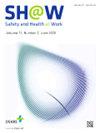Exploring Intervention Strategies to Prevent Occupational Heat Stress. A Scoping Review
IF 2.9
3区 医学
Q1 PUBLIC, ENVIRONMENTAL & OCCUPATIONAL HEALTH
引用次数: 0
Abstract
Rising global temperatures threaten workers worldwide, especially in outdoor and indoor industries like construction, manufacturing, agriculture, and mining. The current guidelines for reducing heat-related risks in these sectors lag behind those in sports and military settings. The objective of this study is to map applicable strategies across various sectors and summarize preventive strategies and methodologies. A scoping review was conducted using the Preferred Reporting Items for Systematic reviews and Meta-Analyses (PRISMA) extension for scoping reviews. PubMed and ScienceDirect were searched for articles on internal, external, and administrative interventions. In total, 5,280 articles published between January 2020 and March 2024 were initially identified. Following a meticulous screening process, 49 articles were selected for in-depth review in this study. Notably, a considerable proportion (56%) of these studies focused on external interventions. This review revealed that a multifaceted approach is necessary to enhance the decision-making process for effectively addressing heat stress, regardless of occupational settings. This approach encompasses considerations of environmental factors, individual physiological aspects, and cooling methods. The review also highlighted limitations in effective and practical heat stress prevention strategies across various industry sectors, including the absence of dietary guidelines.
职业性热应激预防干预策略探讨。范围检讨
全球气温上升威胁着全世界的工人,尤其是建筑、制造业、农业和采矿业等室外和室内行业的工人。目前在这些领域减少高温相关风险的指导方针落后于体育和军事领域。这项研究的目的是绘制各部门的适用战略,并总结预防战略和方法。使用系统评价和元分析首选报告项目(PRISMA)扩展范围评价进行范围评价。PubMed和ScienceDirect检索了关于内部、外部和行政干预的文章。初步确定了2020年1月至2024年3月期间发表的5280篇文章。经过细致的筛选,本研究选择了49篇文章进行深入的综述。值得注意的是,这些研究中有相当大比例(56%)侧重于外部干预。该综述表明,无论职业环境如何,都需要采用多方面的方法来提高有效解决热应激的决策过程。这种方法包括环境因素、个体生理方面和冷却方法的考虑。该综述还强调了各个行业在有效和实用的热应激预防策略方面的局限性,包括缺乏饮食指南。
本文章由计算机程序翻译,如有差异,请以英文原文为准。
求助全文
约1分钟内获得全文
求助全文
来源期刊

Safety and Health at Work
Social Sciences-Safety Research
CiteScore
6.40
自引率
5.70%
发文量
1080
审稿时长
38 days
期刊介绍:
Safety and Health at Work (SH@W) is an international, peer-reviewed, interdisciplinary journal published quarterly in English beginning in 2010. The journal is aimed at providing grounds for the exchange of ideas and data developed through research experience in the broad field of occupational health and safety. Articles may deal with scientific research to improve workers'' health and safety by eliminating occupational accidents and diseases, pursuing a better working life, and creating a safe and comfortable working environment. The journal focuses primarily on original articles across the whole scope of occupational health and safety, but also welcomes up-to-date review papers and short communications and commentaries on urgent issues and case studies on unique epidemiological survey, methods of accident investigation, and analysis. High priority will be given to articles on occupational epidemiology, medicine, hygiene, toxicology, nursing and health services, work safety, ergonomics, work organization, engineering of safety (mechanical, electrical, chemical, and construction), safety management and policy, and studies related to economic evaluation and its social policy and organizational aspects. Its abbreviated title is Saf Health Work.
 求助内容:
求助内容: 应助结果提醒方式:
应助结果提醒方式:


